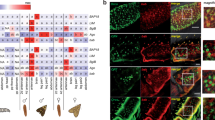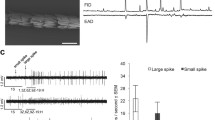Abstract
The sex pheromone communication system of the European corn borer moth varies intraspecifically. Analyses of pheromonal extracts of wild females, collected in a region where the types (each producing a different isomeric proportion ofZ- andE-11-tetradecenyl acetate) are sympatric, showed that theZ pheromone-production allele frequency was ca. 4 times greater than theE allele. The paucity ofE production and response alleles in the population indicates that moths inheriting those alleles concomitantly inherit some undefined disadvantage. The types interbreed, but the frequency of heterozygous pheromone-production types among wild females was less than predicted by Hardy-Weinberg equilibrium and was evidence of positive assortative mating. Rates of male captures in field traps baited with females of the three pheromonal types also evidenced assortative mating in the population. Progeny tests with males captured in the traps provided circumstantial evidence that pheromone response and production functions in the species are regulated by separate genetic loci and that the loci are not always complementary; i.e., a male can carry an allele coding for production of one pheromonal isomer ratio but can be genetically predisposed to respond to another.
Similar content being viewed by others
References
Anglade, P., Stockel, J., andI.W.G.O. Cooperators. 1984. Intraspecific sex variability in the European com borer,Ostrinia nubilalis Hbn. (Lepidoptera, Pyralidae).Agronomie 4:183–187.
Bailey, J.B., McDonough, L.M., andHoffman, M.P. 1987. Western avocado leaf-roller,Amorbia cuneana (Walsingham) (Lepidoptera: Tortricidae): Discovery of populations utilizing different ratios of sex pheromone components.J. Chem. Ecol. 12:1239–1245.
Buechi, R., Preisner, E., andBrunetti, R. 1982. Das sympatrische vorkommen von zwei pheromonstämmen des maisezünslers, Ostrinia nubilalis Hbn. in der südschweiz.Mitt. Schweiz. Entomol. Ges. 55:33–53.
Drecktrah, H.G., andBrindley, T.A. 1967. Morphology of the internal reproductive systems of the European corn borer.Iowa State J. Sci. 41:467–480.
Glover, J.J., Tang, X.-H., andRoelofs, W.L. 1987. Sex pheromone blend discrimination by male moths fromE andZ strains of European corn borer.J. Chem. Ecol. 13:143–151.
Grant, G.G., Frech, D., andGrisdale, D. 1975. Tussock moths: Pheromone cross stimulation, calling behavior, and effect of hybridization.Ann. Entomol. Soc. Am. 68:519–524.
Grule, J.W., andTaylor, O.R., Jr. 1979. The inheritance of pheromone production in the sulphur butterfliesColias eurytheme andC. philodice.Heredity 42:359–371.
Hartl, D.L. 1980. Principles of Population Genetics. Sinauer Associates, Sunderland, Massachusetts.
Hansson, B., Lofstedt, C., andRoelofs, W.L. 1987. Inheritance of olfactory response to sex pheromone components inOstrinia nubilalis.Naturwissenenschafien 74:497–499.
Kitteredge, J.S., andTakahashi, F.T. 1972. The evolution of sex pheromone communication in the arthropoda.J. Theor. Biol. 35:467–471.
Klun, J.A., andCooperators. 1975. Insect sex pheromones: Intraspecific pheromonal variability ofOstrinia nubilalis in North America and Europe.Environ. Entomol. 4:891–894.
Klun, J.A., andMaini, S. 1979. Genetic basis of an insect chemical communication system: The European corn borer.Environ. Entomol. 8:423–426.
Klun, J.A., Chapman, O.L., Mattes, K.C., Wojthkowski, P.W., Beroza, M., andSonnet, P.E. 1973. Insect sex pheromones: Minor amount of opposite geometrical isomer critical to attraction.Science 181:661–663.
Klun, J.A., Leonhardt, B.A., Lopez, J.D., Jr., andLaChance, L.E. 1982. FemaleHeliothis subflexa (Lepidoptera: Noctuidae) sex pheromone: Chemistry and congeneric comparisons.Environ. Entomol. 11:1084–1090.
Lanier, G.N. 1970. Pheromones: Abolition of specificity in hybrid bark beetles.Science 169:71–72.
Lanier, G.N. 1972. Biosystematics of the genusIps (Coleoptera: Scolytidae) in North America. Hopping's groups IV and X.Can. Entomol. 104:361–388.
Lanier, G.N., Birch, M.C., Schmitz, R.F., andFurniss, M.M. 1972. Pheromones ofIps pini (Coleoptera: Scolytidae): Variation in response among three populations.Can. Entomol. 104:1917–1923.
Mitter, C., andKlun, J.A. 1987. Evidence of pheromonal constancy among sexual and asexual females in a population of fall cankerworm,Alsophila pometaria (Lepidoptera: Geometridae).J. Chem. Ecol. 13:1823–1831.
Raulston, J.R., Lingren, P.E., Sparks, A.N., andMartin, D.F. 1979. Mating interaction between native tobacco budworms and released backcross adults.Environ. Entomol. 8:349–353.
Reed, G.L., Showers, W.B., Huggans, J.L., andCarter, S.W. 1972. Improved procedures for mass rearing the European com borer.J. Econ. Entomol. 65:1472–1476.
Roelofs, W.L., Du, J.-W., Tang, X.-H., Robbins, P.S., andEckenrode, C.J. 1985. Three European corn borer populations in New York based upon sex pheromones and voltinism.J. Chem. Ecol. 11:829–836.
Roelofs, W.L., Glover, T., Tang, X.-H., Sreng, I., Robbins, P., Eckenrode, C., Löfstedt, C., Hansson, B.S., andBengtsson, B.O. 1987. Sex pheromone production and perception in European com borer moths is determined by both autosomal and sex-linked genes.Proc. Natl. Acad. Sci. U.S.A. 84:7585–7589.
Sanders, C.J., Daterman, G.E., andEnnis, T.G. 1977. Sex pheromone responses ofChoristoneura spp. and their hybrids (Lepidoptera: Tortricidae).Can. Entomol. 109:1201–1220.
Schwarz, M.,Klun, J.A.,Fritz, G.L.,Uebel, E.G., andRaina, A.K. 1988. European com borer sex pheromone: Structure-activity relationships.J. Chem. Ecol. In press.
Webster, R.P., Charlton, R.E., Schal, C., andCardé, R.T. 1986. High-efficiency pheromone trap for the European corn borer (Lepidoptera: Pyralidae).J. Econ. Entomol. 79:1139–1142.
Author information
Authors and Affiliations
Rights and permissions
About this article
Cite this article
Klun, J.A., Huettel, M.D. Genetic regulation of sex pheromone production and response. J Chem Ecol 14, 2047–2061 (1988). https://doi.org/10.1007/BF01014249
Received:
Accepted:
Issue Date:
DOI: https://doi.org/10.1007/BF01014249




